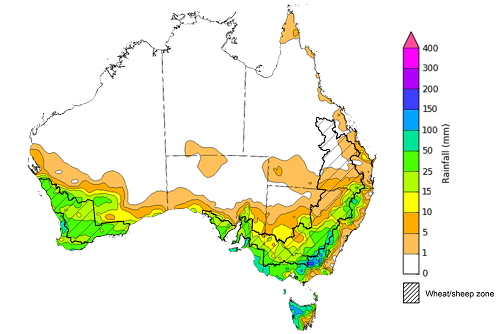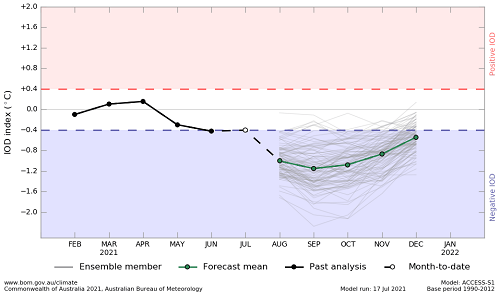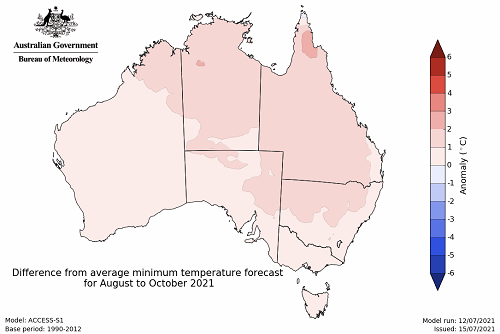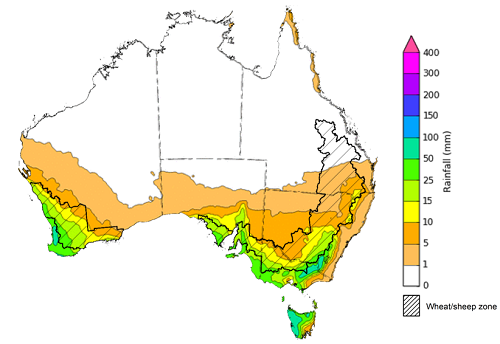Key issues
- During the week ending 21 July 2021, cold fronts and troughs brought rainfall to much of southern Australia. A high-pressure system and associated cloud free skies saw little to no rainfall across the northern half of the country.
- Above average soil moisture for most cropping regions likely supported on-going crop development, even in regions that received little to no rainfall. Parts of eastern South Australia received between 10 and 25 millimetres this week which constitutes their highest weekly rainfall total for the current winter growing season.
- The Bureau of Meteorology this week officially declared the establishment of a negative Indian Ocean Dipole (IOD) event, following eight weeks of negative index values. A negative IOD event increases the chance of above average rainfall for southern and eastern Australia and the far north during winter and spring. It is also typically associated with an early onset of northern rainfall.
- The outlook for August 2021 indicates that there is a 75% chance of rainfall totals between 10 and 100 millimetres across parts of eastern, south-western and far southern Australia. Rainfall totals in excess of 100 millimetres are expected across alpine regions of New South Wales and Victoria, the west coast of Tasmania and isolated parts of south-western Australia.
- The outlook for August to October suggests there is a 75% chance of receiving between 50 and 200 millimetres across cropping regions in New South Wales, Victoria, South Australia and Western Australia, as well as much of Queensland. Totals of less than 50 millimetres are expected in isolated northern cropping regions in Queensland and Western Australia.
- Low pressure systems and cold fronts across southern Australia are likely to bring rainfall to parts of New South Wales, Victoria, South Australia, Western Australia and Tasmania over the next 8 days to 29 July 2021. However, high pressure systems to the north are likely to prevent substantial rainfalls for northern parts of Australia, including Queensland and the Northern Territory.
- The forecast rainfall for cropping regions will continue to support the growth of early sown crops and establishment of later sown crops, as well as boosting soil moisture. Those parts of eastern South Australia, which recorded good falls this week are likely to receive some follow-up rainfall over the coming 8-days.
- Water storage in the Murray–Darling Basin (MDB) increased by 776 gigalitres (GL) between 14 July 2021 and 21 July 2021. The current volume of water held in storage is 17,693 GL, which represents 70% of total capacity. This is 51% or 5,981 GL more than at the same time last year.
- Allocation prices in the Victorian Murray below the Barmah Choke have not been updated this week due to data source issues. On 9 July 2021 the allocation prices were $184 per ML. Prices are lower in the Goulburn-Broken, Murrumbidgee, and regions above the Barmah choke due to the binding of the Goulburn intervalley trade limit, Murrumbidgee export limit, and Barmah choke trade constraint.
Climate
[expand all]
Rainfall this week
During the week ending 21 July 2021, cold fronts and troughs brought rainfall to much of southern Australia. The rainfall was interrupted by a high-pressure system over central Australia in the middle of the week. This high-pressure system and associated cloud free skies saw little to no rainfall across the northern half of the country.
Rainfall totals of between 10 and 50 millimetres were recorded across parts of eastern and southern New South Wales, isolated areas of south-eastern Queensland, the south of South Australia, the south-west of Western Australia and Tasmania, as well as much of Victoria. Rainfall totals in excess of 50 millimetres were recorded in isolated parts of eastern New South Wales, Victoria, South Australia, Western Australia and Tasmania.
In cropping regions, rainfall totals of between 10 and 50 millimetres were recorded in eastern and southern New South Wales and most of Victoria, South Australia and Western Australia. Little to no rainfall was recorded across cropping regions in north-western New South Wales and Queensland during the week ending 21 July 2021.
Above average soil moisture for most cropping regions likely supported on-going crop development, even in regions that received little to no rainfall. Parts of eastern South Australia received between 10 and 25 millimetres this week which constitutes their highest weekly rainfall total for the current winter growing season. However, continued weekly rainfall totals of between 15 and 50 millimetres leaves low lying areas across areas of central New South Wales and southern Western Australia at risk of crop losses due to waterlogging.
Rainfall for the week ending 21 July 2021
©Commonwealth of Australia 2021, Australian Bureau of Meteorology - Issued: 21/07/2021
Note: The rainfall analyses and associated maps utilise data contained in the Bureau of Meteorology climate database, the Australian Data Archive for Meteorology (ADAM). The analyses are initially produced automatically from real-time data with limited quality control. They are intended to provide a general overview of rainfall across Australia as quickly as possible after the observations are received. For further information go to http://www.bom.gov.au/climate/rainfall/
Climate Drivers
Throughout winter the climate drivers with the largest potential impact on Australia’s climate patterns are the El Niño–Southern Oscillation (ENSO), the Indian Ocean Dipole (IOD) and the Southern Annular Mode (SAM). These climate drivers will likely influence the outlook for Australia’s winter cropping season.
The Bureau of Meteorology this week officially declared the establishment of a negative IOD event in the Indian Ocean, following eight weeks of negative index values. A negative IOD event increases the chance of above average rainfall for southern and eastern Australia and the far north during winter and spring. It is also typically associated with an early onset of northern rainfall.
ENSO conditions, on the other hand, remain neutral according to oceanic and atmospheric indicators, reducing its influence on Australia’s climate. International climate models surveyed by the Bureau of Meteorology agree that ENSO conditions are likely to remain neutral throughout August. Three of the seven models, however, expect the development of a La Niña event in mid-to-late spring. Only one model expects a La Niña event in December. The SAM has also returned to neutral and is expected to remain neutral over the coming weeks. It is therefore unlikely to have a significant influence on Australia’s climate.
Sea surface temperature anomalies have been close to average across the tropical Pacific Ocean over the previous week. Warm anomalies in the western Pacific have weakened slightly, while warm anomalies near the Maritime Continent and along the east coast of Australia have persisted. Neutral Pacific equatorial sea surface temperatures are associated with neutral ENSO conditions.
Warm sea surface temperature anomalies have persisted near Western Australia and Indonesia. Meanwhile, sea surface temperatures in the western Indian Ocean largely remained neutral over the past week. The warm anomalies in the eastern Indian Ocean and the ocean surrounding Australia underpin the establishment of the negative IOD event.
Difference from average sea surface temperature observations 12 July to 18 July 2021
As at 18 July, the Indian Ocean Dipole (IOD) weekly value was -0.62°C. This is the eighth consecutive week that the IOD has been below the negative threshold (-0.4°C). A negative IOD, and warmer sea surface temperatures in the eastern Indian Ocean, is associated with above average rainfall for much of southern Australia in winter and spring. It also increases the chances of below average maximum temperatures in southern Australia, while increasing the chances of above average minimum and maximum temperatures in northern Australia.
Although the Madden-Julian Oscillation (MJO) doesn’t directly influence the Australian climate at this time of year, the strengthening of an MJO to Australia’s north may reinforce the impact of the negative IOD event. The majority of international climate models surveyed by the Bureau of Meteorology expect the negative IOD event to persist until November, with all but one model expecting a return to neutral conditions in December.
Monthly sea surface temperature anomalies for IOD region
National Climate Outlook
These climate outlooks are generated by ACCESS–S (Australian Community Climate Earth-System Simulator–Seasonal). ACCESS–S is the Bureau of Meteorology's dynamical (physics-based) weather and climate model used for monthly, seasonal and longer-lead climate outlooks.
For further information, go to http://www.bom.gov.au/climate/ahead/about/
The Bureau of Meteorology’s latest rainfall outlook indicated wetter than average conditions are expected for much of eastern and central Australia during August. The wetter than average conditions expected for most cropping regions reaffirms the positive production outlook for Australia’s 2021 winter cropping season. The ACCESS-S climate model suggests there is close to a 65% chance of exceeding average August rainfall totals across much of Australia.
The outlook for August 2021 indicates that there is a 75% chance of rainfall totals between 10 and 100 millimetres across parts of eastern, south-western and far southern Australia. Rainfall totals in excess of 100 millimetres are expected across alpine regions of New South Wales and Victoria, the west coast of Tasmania and isolated parts of south-western Australia.
Across cropping regions there is a 75% chance of rainfall totals of between 5 and 10 millimetres in parts of northern Queensland. There is a 75% chance of rainfall totals between 10 and 50 millimetres for New South Wales, southern Queensland, Victoria, South Australia and Western Australia. These expected rainfall for August will support the ongoing growth, and eventual yield development, of winter crops in most regions. Parts of New South Wales and Western Australia are already exceptionally wet, and substantial rainfall may negatively impact crop development and yield potential.
Rainfall totals in some cropping regions of western Victoria and eastern South Australia, are currently tracking at well below average for the winter growing season. These areas have a 75% chance of receiving 10 to 25 millimetres in August. If realised, these falls will support the establishment and growth of dry-planted crops in these regions.
Rainfall totals that have a 75% chance of occurring August 2021
©Commonwealth of Australia 2021, Australian Bureau of Meteorology - Issued: 15/07/2021
The rainfall outlook for August to October suggests there is a greater than 80% chance of exceeding average rainfall across much of New South Wales, Queensland, Victoria, South Australia and the Northern Territory. There is no strong tendency toward above or average rainfall across the west of Western Australia and parts of Tasmania (Bureau of Meteorology ‘National Climate Outlook’, 15 July 2021).
Bureau of Meteorology rainfall outlooks for August to October have greater than 55% past accuracy across most of Australia. Outlook accuracy is greater than 65% across much of New South Wales, Queensland, the north of South Australia and much of the Northern Territory. On the other hand, there is low past accuracy for isolated areas of southern Western Australia and parts of eastern New South Wales and Victoria.
Chance of exceeding the median rainfall August to October 2021
©Commonwealth of Australia 2021, Australian Bureau of Meteorology - Issued: 15/07/2021
The outlook for August to October suggests there is a 75% chance of rainfall totals between 50 and 200 millimetres across much of New South Wales and Victoria, and parts of south-eastern Queensland, the south of Southern Australia, the south of Western Australia and eastern Tasmania. Rainfall totals in excess of 300 millimetres are likely across parts of alpine regions of New South Wales and Victoria, and the far south-west of Western Australia and western Tasmania.
Across cropping regions, there is a 75% chance of receiving between 50 and 200 millimetres in New South Wales, Victoria, South Australia and Western Australia, as well as much of Queensland. Totals of less than 50 millimetres are expected in isolated northern cropping regions in Queensland and Western Australia.
These rainfall totals are slightly below average for this three-month period across some Western Australian cropping regions, and slightly above average for cropping regions of New South Wales, Queensland and Victoria. Above average soil moisture levels in New South Wales and parts of Queensland, and the probability of close to average in-season rainfall in August to October, will assist with maintaining or improving current yield potential in most winter cropping regions.
Rainfall totals that have a 75% chance of occurring August to October 2021
©Commonwealth of Australia 2021, Australian Bureau of Meteorology - Issued: 15/07/2021
The temperature outlook for August to October 2021 indicates that maximum temperatures across most of Australia are likely to be close to the 1990-2012 average (- 1°C to 1°C). Minimum temperatures are expected to be slightly above average for much of Queensland and the Northern Territory, as well as parts of New South Wales, South Australia and Western Australia (Bureau of Meteorology ‘National Climate Outlook’, 15 July 2021).
Predicted maximum temperature anomaly for August to October 2021
Predicted minimum temperature anomaly for August to October 2021
Rainfall forecast for the next eight days
Low pressure systems and cold fronts across southern Australia are likely to bring rainfall to parts of New South Wales, Victoria, South Australia, Western Australia and Tasmania over the next 8 days to 29 July 2021. However, high pressure systems to the north are likely to prevent substantial rainfalls for northern parts of Australia, including Queensland and the Northern Territory.
Rainfall totals of between 10 and 50 millimetres are forecast for isolated parts of New South Wales and Queensland, as well as much of Victoria, the south of South Australia, south-west Western Australia and much of Tasmania.
In Australia’s cropping regions, rainfall totals of between 10 and 25 millimetres are forecast for south-eastern New South Wales and isolated parts of south-east Queensland, as well as much of Victoria, South Australia and Western Australia. Rainfall totals in excess of 25 millimetres are forecast in isolated parts of New South Wales, Victoria, South Australia and Western Australia.
The forecast rainfall for cropping regions will continue to support the growth of early sown crops and establishment of later sown crops, as well as boosting soil moisture. Those parts of eastern South Australia, which recorded good falls this week are likely to receive some follow-up rainfall over the coming 8-days.
Soil moisture levels are above average across eastern and western cropping regions, which will support ongoing crop growth and eventual yield potential. The low rainfall expected for much of central and northern New South Wales will provide a reprieve from potential waterlogging. The forecast rainfall for parts of Western Australia, on the other hand, may exacerbate waterlogging, negatively affecting crop growth.
Total forecast rainfall (mm) for the period 22 July to 29 July 2021
©Commonwealth of Australia 2021, Australian Bureau of Meteorology - Issued: 21/07/2021
Water
Water storages, water markets and water allocations - current week
The Tableau dashboard may not meet accessibility requirements. For information about the contents of these dashboards contact ABARES.
Commodities
Information on weekly price changes in agricultural commodities is now available at the Weekly commodity price update.









